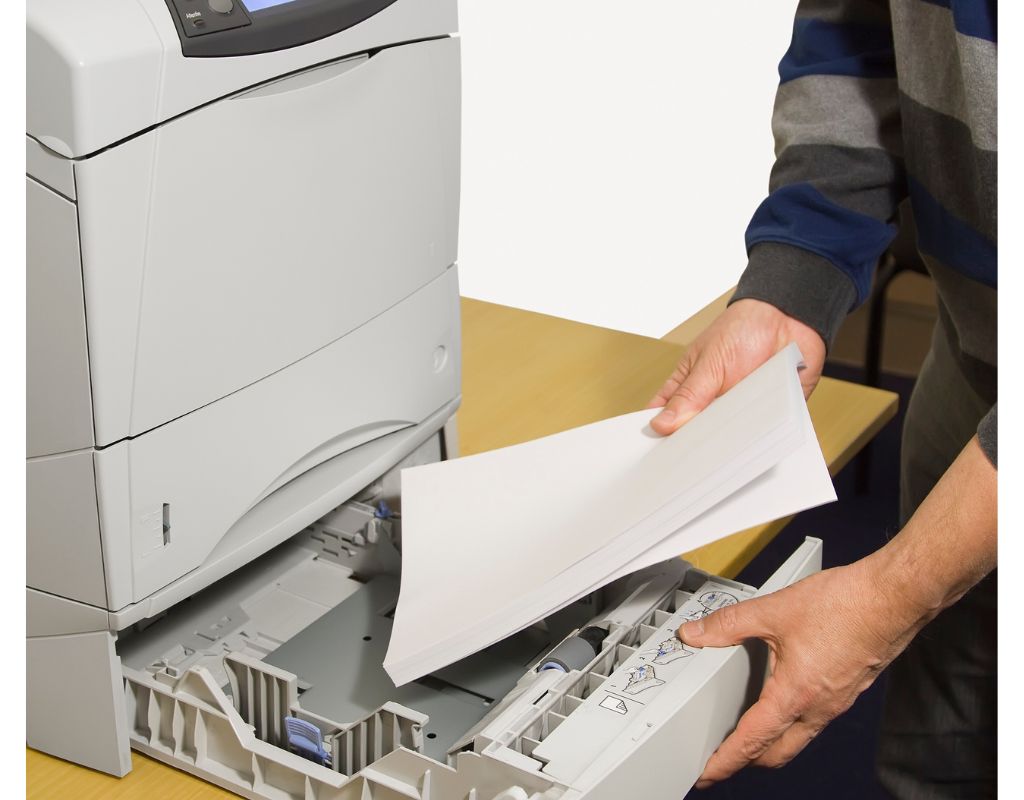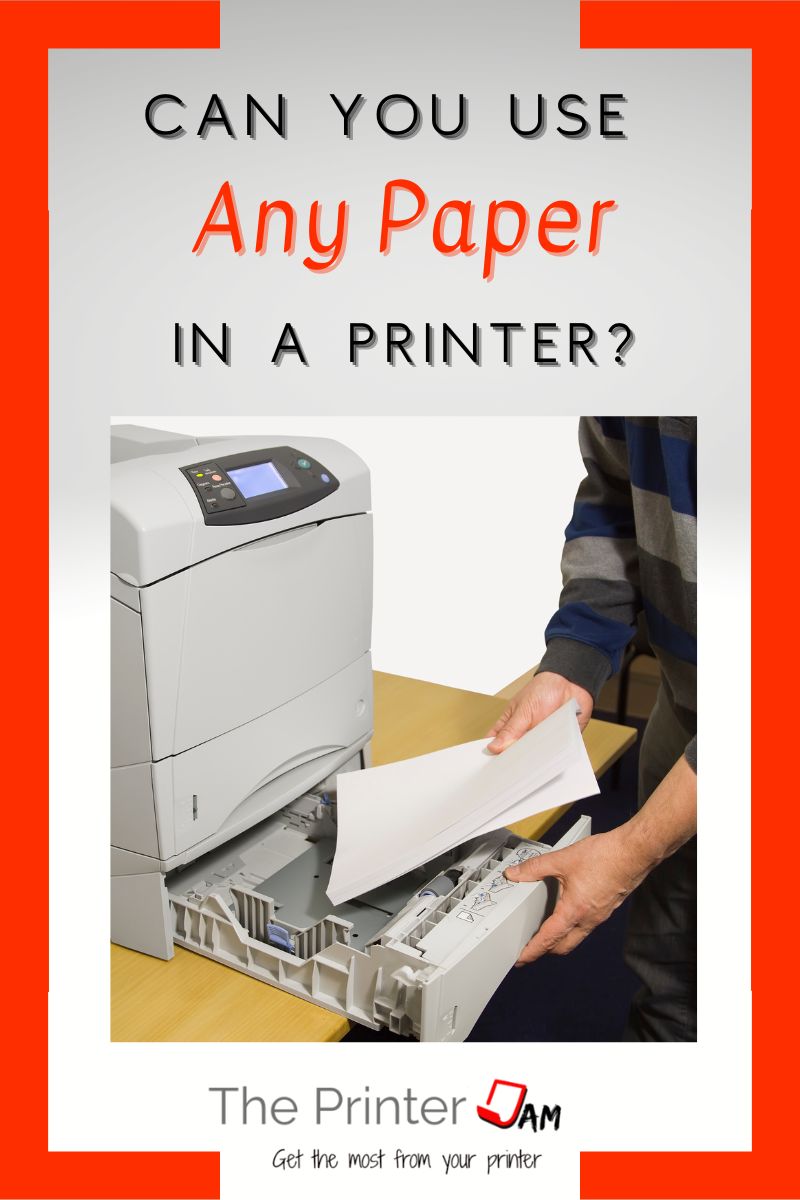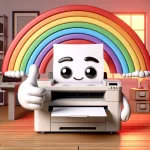
According to a printers guidelines you can’t use just any paper in a printer. In my experience fixing printers, that’s a disclaimer to avoid any responsibility in case there’s a paper jam.
However, I’ve seen many printers use paper that isn’t within those guidelines. For example, vellum and construction paper are used in printers all the time.
If you want to know if you can use any paper the answer is a printer can, within reason! Don’t go loading toilet paper or roofing paper in your printer.
In most cases paper manufacturers will let you know what kind of printer their paper can be used with.
The only paper to be cautious with is specially coated paper, labels, and transparencies. These types of paper are made for specific types of printers. In other words, coated paper for inkjet printers shouldn’t be used in a laser printer.
While manufacturers only recommend a few types of paper. In my experience fixing printers for 25 years printers can use more kinds of paper than the manufacturer says.
Suitable Paper Types for Printers
Suitable kinds of paper for a printer also include size. The smallest size is typically 4 x6. While 13 x 19 is the largest. Any larger comes in rolls.
The standard issue paper for printers is 8½ x11 20lbs bond, suitable for any printer. In fact most paper used in printers are based on bond paper.
For example, copy, multipurpose, color, printer, laser, and some photo paper are all bond type paper. The differences are with smoothness, brightness, finishes, or coatings.
Index, cover, text, book, and bond are different types of paper used in printers. Most of those paper types are used in commercial printing. However, many home printers are able to handle these types of paper.
Many transfer, craft, notebook, or sublimation papers are also based on those types of paper. Which are suitable for printers.
Certain labels aren’t made for printers. If labels or stickers are designed to be used in a printer it will say so. Labels or stickers for printers work with either type of printer.
Transparencies have temperature ratings for heat. Larger copiers and high speed laser printers require high temp transparencies. Transparency paper is also made for inkjet printers.
Construction paper doesn’t say but it works in either type of printer. It’s no different than using Cardstock paper. Construction paper is on the thick side but not too thick for inkjet or laser printers.
Index paper is heaviest paper I’ve seen used in a printer. Either type of printer will struggle feeding too thick or too thin paper. If you don’t mind dealing with an occasional paper jam it can be used in any printer.
Tissue paper isn’t made for printers however, you can use heat tape to attach it to another sheet of paper to print on it. Wrapping paper isn’t as thin as tissue paper so it doesn’t need a carrier sheet.
Paper Not Suitable for a Printer
While there are many suitable types and paper sizes. It’s worth mentioning paper not suitable for printers. Such as paper for manufacturing, janitorial supplies, or building materials.
It should go without saying but don’t use these papers in your printer:
- Roofing paper
- Subfloor paper
- House wrap
- Wall paper
- Wax paper
- Parchment paper
- Laminate paper
- Onion skin paper
- Toilet paper
- Paper towels
- Double ply cardboard.
What Happens to Printers Using Wrong Paper
I’ve seen about everything that can go wrong with a printer having done over 20,000 service calls. When a printer uses paper outside of the printers specifications it usually just jams.
Feed rollers can’t handle too thin or thick paper. They also can’t feed paper too short. The gap between feed rollers isn’t enough to feed paper is shorter than 4 x 6.
In my experience with inkjet printers it’s exceedingly rare for the wrong paper to damage anything inside them. It’s usually removing paper jams that causes damage.
Most paper jams are easy to remove. Particularly hard ones take some patience but can come out without damaging anything.
Using paper not within the specs of a laser printer will also jam more often. The wrong paper doesn’t usually damage anything. However, transparency or label jams require major disassembly to avoid any damage removing the printer jam
In my experience damaged fusers aren’t common. It takes the wrong type transparency to really damage a fuser.
Construction paper may shorten the expected life of a fuser by a small percentage. Considering the smallest fuser lasts 80,000 pages, getting only 75,000 pages isn’t a big deal.
The worst that can happen is a drum unit or fuser needs replaced. Although for many home printers, the fuser isn’t available so it means the printer needs thrown away.
Summary
If by any you truly mean any paper, then no printers can’t use every kind of paper possible. Some paper is too thin or too thick for the feed rollers found in inkjet and laser printers. Other paper just isn’t going to accept any ink or toner.
Any paper, within reason, can be used in a printer.
FAQ
HP printers don’t require special paper to print. You can use almost any type of bond paper in HP printers. Just don’t use special coated paper in HP laser printers.
The worst that can happen to an inkjet printer is it jams. The ink might smear with the wrong paper.
In a laser printer it could jam too. Only if the paper has a coating, too thin or the wrong material it could wrap around the fuser. Which will require disassembly to remove.
Copy paper(20lbs bond) is what I see most printers using. A good multipurpose paper is better for any printer. Color or laser paper is best for color printing.

The Copier Guy, aka Dave. I’ve worked on scanners, printers, copiers, and faxes since 1994. When I’m not fixing them I’m writing about them. Although, I’m probably better at fixing them. I’ve worked with every major brand. As well as several types of processes. If it uses paper I’ve probably worked on one.





